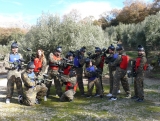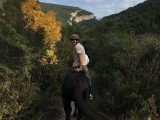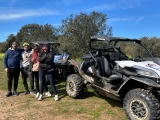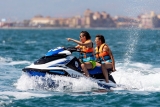Climbing is a sport that demands intense concentration, technique, strict adherence to safety rules and self-confidence. Fancy giving it a go?

Climbing Classes at an Indoor Climbing Wall
Perhaps the best way to start climbing is to visit an indoor climbing centre with specialised instructors who run courses, introduce you to the basic gear you'll need, teach you how to use all the climbing equipment and, most crucially: they'll explain climbing safety rules, something you must always keep in mind.
As you won't have your own gear initially, wear stretchy, comfortable clothing, trainers that support your feet well, and if you're a girl, tie your hair back :).

After that first session when you tackle the wall, you'll realise it's more about technique than brute strength. The instructor will give you the key tips needed to move from hold to hold and help build your confidence.
Outdoor Rock Climbing Trips
Only once you've gained experience and visited the climbing wall regularly should you consider outdoor climbing trips with your climbing partners, provided they're experienced enough to belay you or you go with an instructor.

Most climbing centres organise regular outdoor trips for members and students, so you can easily sign up. Ask about them!
Technical Tips
- Initially, look for routes or boulder problems (when starting out, the latter aren't recommended as they don't use ropes) that, while challenging, feel manageable. Attempting overly difficult climbs may lead to frustration. Take it step by step.
- Use your legs. You might think arms do all the work, but that's not true: leg muscles are the body's strongest and should drive your movement.
- If you can't reach a hold directly, it's better to find an alternative path than overstretch. You might fall short, fail or injure yourself.

- If you feel stuck mid-climb, focus on your position, take your time and adjust your footwork. Try not to panic.
- Bring enthusiasm and determination. It's an incredibly rewarding sport, though quite tough initially. Don't be discouraged – the effort pays off.
- Practice falling techniques, as falls are common. Knowing how to fall prevents injuries.
- Train your mind. Use common sense, be honest about your abilities, learn to stay calm under pressure and keep a cool head.

Learn Climbing Terminology
Here's a glossary to help you follow climbers' conversations:
- Routes. The path up the wall from ground to anchor point. A wall has multiple routes if there are several anchor points.
- Anchor. In climbing, this isn't a social meet-up but the fixed point at a route's end. There'll be a carabiner or ring where the lead climber threads the rope. If you're not leading, you can relax here enjoying the view.
- Boulder problem. A short, rope-free climb with specific moves. Not very high as falls are expected.

- Grades. Indicate route difficulty. In Spain we use French grades (7a, 6c, 8b+...) which have equivalents in the Anglo-Saxon system.
- Lead climbing. When the first climber ascends, clipping quickdraws to protection points along the route.
- Belayer. The person at the base managing the rope via a belay device attached to their harness, securing the climber.
- Overhang. When the rock face angles outward. Steepness determines whether only experienced climbers can tackle it.
- Climbing shoes. Despite the name, no feline connection! Special tight-fitting shoes with sticky rubber soles for better grip.
- Crash pad. Portable mat placed beneath boulderers to cushion falls.

- Figure-eight knot. The standard knot for tying the rope to your harness.
- Holds. Resin moulds on climbing walls for hand/foot placement.
- Grigri. An assisted-braking belay device that automatically locks if the climber falls, even if the belayer isn't paying attention.
- Chalk. Like talcum powder, it absorbs sweat to prevent slipping. Banned in some protected natural areas.
- Quickdraws. Two carabiners connected by a short sling.











